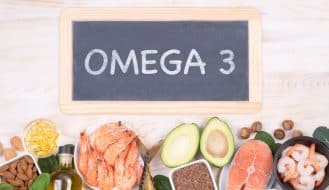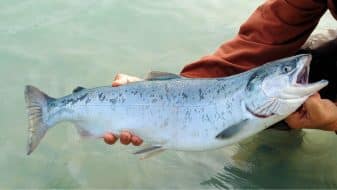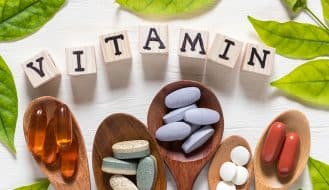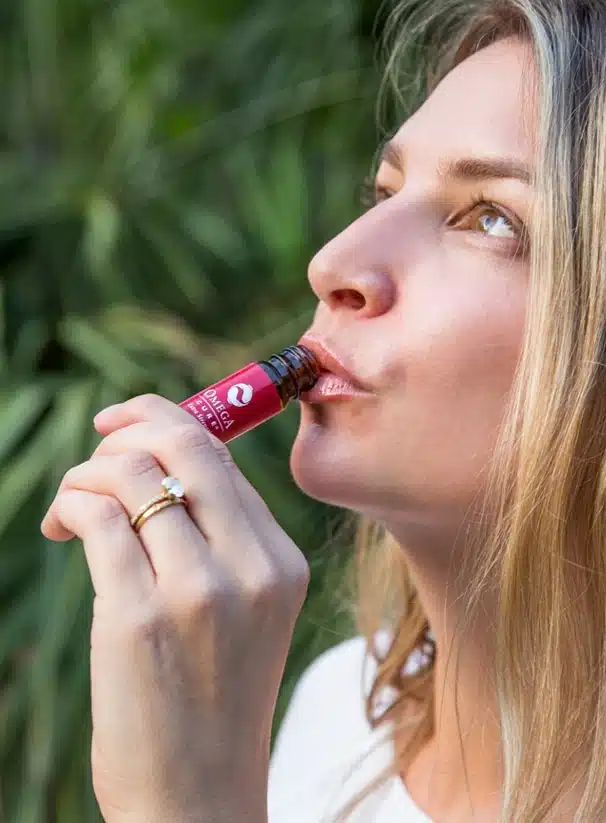9 Foods That Are Very High in Omega-3s
Are you looking to boost your omega-3 levels? That’s a smart move, considering that a staggering 80% of people fail to get even half the recommended daily intake of these important fatty acids [1].
This widespread deficiency is a problem. Low omega-3 levels are linked to a range of health issues, including heart disease, mood disorders, and chronic inflammation.
Getting enough of these essential fatty acids allows every cell in your body to function its best. So let’s take a look at the best omega-3 foods and how you can ensure you get enough for optimal health benefits.
Different Types of Omega-3s
Before we launch into a discussion of food sources, it’s important to clear up one important point: There are different types of omega-3s.
The word “omega-3” represents a family of fatty acids. All of the different family members play unique roles in the cell. Ideally, we want them all.
While there are many types of omega-3s, we’ll tackle just the three most important ones in this article. They are:
- DHA (Docosahexaenoic acid) – Considered the most important omega-3 for the brain and eyes.
- EPA (Eicosapentaenoic acid) – Recognized for its big impact on mental health and inflammation.
- ALA (Alpha-linolenic acid) – Primarily found in plants.
ALA vs. EPA and DHA
Since their discovery about 50 years ago, it’s EPA and DHA that have gotten almost all the attention in the omega-3 family. When people refer to omega-3 benefits, they’re usually referring to EPA and DHA. These fatty acids fight inflammation, keep our arteries healthy, reduce triglyceride levels, and support brain function.
Having high EPA and DHA levels is considered so important that there are tests designed to measure how much of these two fatty acids you have in your body. Notably, having a high EPA and DHA level is linked to improved cardiovascular health and even living 5 years longer on average.
ALA doesn’t have as much research behind it as EPA and DHA. But there is some evidence that eating more than 2000 mg of ALA daily could lower the risk of heart disease [2].
Plant-Based Foods High in Omega-3
Now that we got that out of the way, let’s get to the fun part – the food. Let’s first tackle a few plant-based sources and how they’re different from seafood.
#1) Seaweed
Unfortunately for those following a vegetarian or vegan diet, most plants don’t contain ANY of the beneficial EPA and DHA fatty acids. One notable exception though is fresh seaweed!
In seaweed, like wakame, about 13% of the oil composition is made up of EPA. Researchers have noted that people could meet their recommended DHA and EPA intake by consuming as little as 3/4 cups of fresh seaweed daily [4].
It’s worth noting that how much omega-3 you get from the seaweed does depend on the species and the seaweed’s life stage. In studies of commercially available seaweed, researchers have found a high degree of variability in the EPA/DHA content. So just like you’ll see with eating fish, it’s wise to keep testing your omega-3 levels to make sure you get enough.

Succulent seaweed: In contrast to other plant omega-3 sources, fresh seaweed can be a good source of EPA and DHA omega-3s.
#2) Flaxseed & Chia Seeds
When it comes to vegetarian sources of omega-3s, flaxseed supplements and chia seeds often top the list of recommendations. But it’s important to remember that both flaxseed and chia seeds do not contain any EPA or DHA. Both of these seed types only provide ALA omega-3.
Flaxseed is the richest source of ALA, providing as much as 6380 mg of ALA per ounce. Chia seeds are also a great source, delivering 4990 mg of ALA per ounce.
In the past, it was believed that if you consumed flaxseed supplements with ALA, your body would convert some of it into EPA and DHA afterwards. Unfortunately, later research has shown this conversion process is negligible. In fact, a 2021 review of multiple studies showed that taking flaxseed oil supplements did not improve omega-3 index levels [5].
This is not to say that flaxseed and chia seeds aren’t valuable. Besides providing ALA omega-3, these seeds are great sources of other much-needed nutrients, like fiber and vitamin E. Flaxseed also provides lignans, which have further health promoting properties.
Importantly, if your goal is to get as much ALA as possible, be sure to grind your flaxseeds and chia seeds. Whole flaxseed and chia seeds deliver much less ALA due to the hard seed coats [6]. You can also opt for flaxseed oil, but keep in mind that certain plant oils, including flaxseed oil, face similar rancidity issues as fish oil.
#3) Walnuts
If you’re nuts about eating nuts, you’re in luck. Walnuts are another respectable source of ALA omega-3. In each ounce, you get roughly 2540 mg of ALA. Plus, this tree nut has the best ratio of polyunsaturated fatty acids relative to saturated fatty acids compared to other varieties.
In research studies, eating more walnuts has been associated with greater life expectancy, a healthier microbiome, and improved lipid profiles [7]. But scientists also make the point that these benefits are likely not tied to ALA alone. In addition to being a good source of healthy fats, walnuts are also good sources of healthy protein, fiber, and many kinds of beneficial antioxidants. All of these components likely work together to provide benefits.
Seafood Omega-3 Sources
If you love to eat fish, we’ve got some good news for you. When it comes to getting a full range of omega-3s, eating seafood is undisputedly the way to go. Seafood delivers the coveted EPA and DHA, along with smaller amounts of ALA, DPA and other types of omega-3 fatty acids.
But not all seafood is equal. Let’s take a closer look at some of the most popular seafood from an omega-3 standpoint.
#4) Herring
Of all the types of fish, let’s give a shout-out to herring for its excellent omega-3 content. Pacific herring delivers on average 1807 mg of EPA + DHA per 3 ounce portion. Atlantic herring is a close second with 1712 mg of EPA + DHA [8]. Considering that most people eat 6 – 8 ounces for a dinner-sized serving, this is a great way to get an effective dose of omega-3s.
Herring is popular in many parts of the world. Scandinavia in particular has a rich food tradition built around herring. But in the United States, herring often doesn’t get the attention it deserves. If you’d like to get started with eating more herring, check out these tasty ideas.
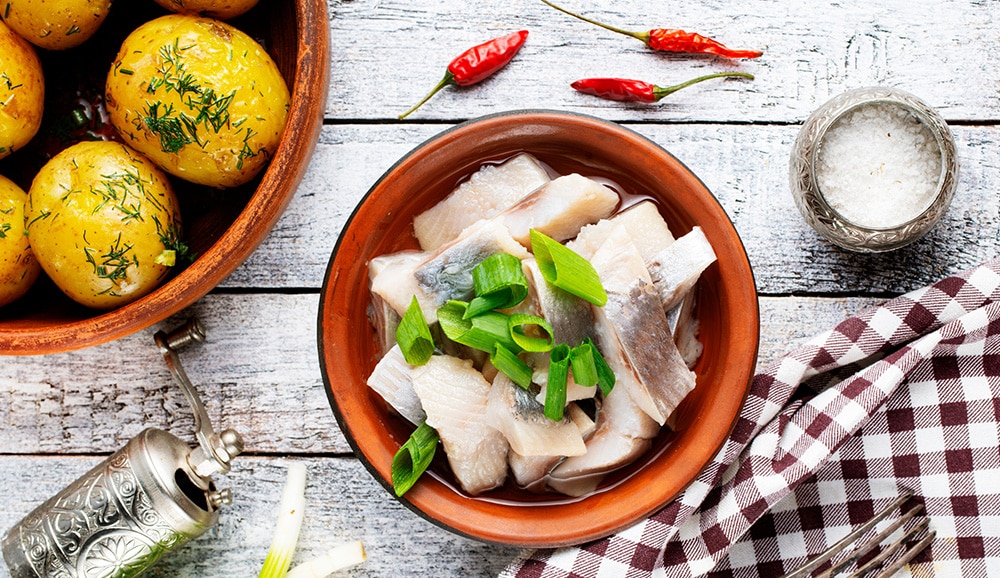
Heart-healthy herring: For an effective omega-3 dose, there are fewer better dietary options than eating herring.
#5) Salmon
In the United States, salmon often leads the list of omega-3-rich fish – and with good reason. A 3 oz portion of wild caught Atlantic salmon might deliver as much as 1564 mg of EPA/DHA.
Now it’s worth noting that the omega-3 content of salmon will depend on the species, how it’s sourced, and also how it is prepared. For example, farmed Atlantic salmon could contain 25% less omega-3 than the wild caught version, all depending on the feed used at the fishery. Similarly, wild caught pink salmon and sockeye salmon contain less omega-3 – roughly 1094 mg and 1046 mg of EPA/DHA respectively [8].
Long story short, salmon is a great source of omega-3s. But how much you get can vary by a big margin. If you have the budget for it, wild caught fish is the best, healthiest option.
#6) Mackerel & Sardines
Mackerel and sardines are two other types of fish to add to your shopping list. Typically, you’ll find them in the canned food aisle. A 3 oz portion of canned mackerel will typically hover around 1046 mg of EPA/DHA. With sardines, you get a little less omega-3 at roughly 835 mg EPA/DHA.
On a personal sidenote: When we were running our medical practices in Norway, my husband would enjoy 1 can of mackerel in tomato sauce on top of sliced bread every day for lunch. Not only did he think it was delicious, but his cholesterol numbers radically improved (those were the days before we discovered Omega Cure® fish oil). Moral of the story: Sardines and mackerel are great additions to a healthy diet.
#7) Tuna
Now tuna is one of those funny fishy categories where you get a big range in omega-3s. For example, Bluefin tuna is a rich source, with 1279 mg of EPA/DHA per 3 oz serving.
But other kinds of tunas don’t contain nearly as much. A 3 oz portion of Skipjack tuna and Yellowfin tuna deliver about as much omega-3 as a regular fish oil capsule. Both clock in under 300 mg of EPA/DHA, which means you need many servings to get an effective daily dose.
Furthermore, there’s a lot of variability in the omega-3 content of canned tuna. For example, a 2018 test by ConsumerLabs found that canned tuna samples might contain as little as 45 mg of EPA/DHA, all the way up to 1200 mg.
In other words, if tuna is your primary source of omega-3s, be vigilant with testing your omega-3 intake.
#8) Shellfish
If you’re a shellfish fan, there’s good news and bad news. The good news is that shellfish – like crab, oysters, mussels, scallops, and shrimp – all provide omega-3s. The bad news is that these levels are a lot lower than you might like.
Of the different types of shellfish options, mussels are your best bet. For example, farmed mussels deliver in the range of 300 – 800 mg of EPA/DHA per 100 grams of cooked meat. Studies have also confirmed that eating mussels 3 times per week is an effective way to improve your omega-3 index levels and meet your omega-3 needs [9].
The same cannot be said for shrimp, which is the most popular seafood in the United States. 3 oz of cooked shrimp doesn’t get you much more than 240 mg of EPA/DHA, according to the National Institute of Health. Plus, in studies, eating shrimp hasn’t produced meaningful increases in omega-3 levels [10, 11].
What about other types of shellfish? Per 3 oz portion, blue crab delivers around 403 mg of EPA/DHA. For Dungeness crab, that level drops to 335 mg. For scallops, the average hovers around 310 mg, whereas clams give you even less at 241 mg.
All of this to say, shellfish is great, but you’ll likely need more help if you want to reach an adequate omega-3 level.
#9) Whitefish
When you talk about the health benefits of omega-3s, you might hear the words “fatty fish” or “oily fish” tossed about. Those terms describe fish that are rich in fatty acids, like salmon, herring, sardines, etc. These fish store their omega-3s in the flesh and muscles that we, as people, like to eat.
Then there’s whitefish, which includes cod, pollock, halibut, sea bass, etc. These fish store the majority of their omega-3s in specific parts of their body, like the liver and head. For instance, you may have heard that cod liver oil is a great source of omega-3s, and that’s true! But if you eat a 3 oz portion of cod fillet, you’ll only get a measly 134 mg of EPA/DHA.
Some whitefish do provide more omega-3s in the meat. Sea bass, for instance, offers a respectable 648 mg of EPA/DHA per 3 ounce portion. Halibut puts you at 395 mg for the same amount.
But other types of whitefish aren’t particularly nutritious on the omega-3 front. Tilapia clocks in at just 115 mg of EPA/DHA, which is far below what you need for meaningful benefits.

Smart supplement: A fresh liquid fish oil, like Omega Cure, provides 3000 mg of EPA/DHA omega-3s in just one tablespoon.
Can You Really Get Enough Omega-3s from Diet Alone?
As you can see above, getting enough omega-3s from your diet is possible. But it does require attention to sourcing and finding the right species if you’re going to succeed.
Studies have shown that in the United States, eating at least two servings of fish per week as recommended doesn’t cut it. It takes three weekly fish meals, plus taking fish oil supplements, to reach an adequate omega-3 index [12].
To make sure you get enough omega-3 fatty acids for optimal health, do the following:
1) Eat omega-3-rich foods regularly:
Aim to eat oily fish 3 times per week. If you are a vegetarian or vegan, it’s likely you’ll need an omega-3 supplement to get EPA and DHA…unless you’re chowing a seaweed salad multiple times a week, of course.
2) Find a liquid omega-3 supplement:
If you’re like most Americans, you’ll probably need an omega-3 supplement in addition to eating a good diet. This is especially true if you are interested in the anti-inflammatory benefits of omega-3s or how these fatty acids impact your triglyceride levels.
Fish oil capsules typically deliver low doses of EPA and DHA, usually around 300 mg EPA/DHA. Consider this: If you’re trying to get as much omega-3 as you would from a salmon dinner, you easily need to swallow 10 capsules per day. Urp!
Liquid fish oil is a smarter way to go. Omega Cure® liquid fish oil provides a salmon dinner’s worth of omega-3s in just one tablespoon. It’s also fresher, offers a broader range of fatty acids, and has a better impact on the microbiome than regular fish oil capsules.
3) Measure your omega-3 levels:
Measuring your omega-3 levels is always a good idea. That’s true whether you are a vegetarian, an avid seafood lover, or if you already take an omega-3 supplement. The reality is that we’re all different, and there are many variables that affect how much EPA and DHA is absorbed into your body. Measuring your levels allows you to see if your current intake is sufficient and what you can do to improve.
The Takeaway
While it’s certainly possible to meet your omega-3 needs through diet alone, it often requires some careful planning and dedication. By buying more omega-3-rich foods, keeping track of your levels, and perhaps adding on high quality fish oil supplements, you can support your wellness goals effectively.
If you’re looking for a simple, convenient way to boost your omega-3 intake, give Omega Cure Extra Strength a try! In just one pre-measured vial, you’ll get a potent dose of omega-3s without the hassle of swallowing multiple capsules. It’s the perfect addition to your daily routine that helps you feel great — and who doesn’t want that?
An Effective Omega-3 Dose, Made Simple
Experience the Omega3 Innovations difference for yourself with the most effective fish oil supplement on the market.
Buy Now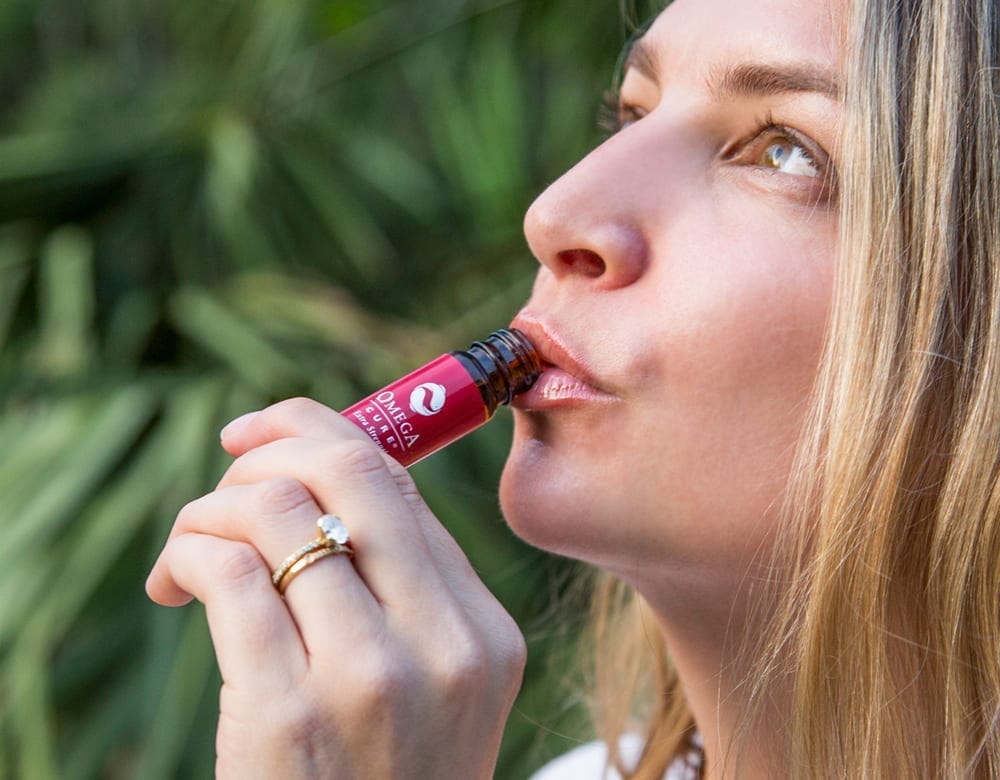
- Tan, K., Lim, L., Peng, Y., & Cheong, K. L. (2023). Effects of Food Processing on the Lipid Nutritional Quality of Commercially Important Fish and Shellfish. Food Chemistry: X, 20, 101034. https://doi.org/10.1016/j.fochx.2023.101034
- Sala-Vila, A., Fleming, J., Kris-Etherton, P., & Ros, E. (2022). Impact of α-Linolenic Acid, the Vegetable ω-3 Fatty Acid, on Cardiovascular Disease and Cognition. Advances in Nutrition (Bethesda, Md.), 13(5), 1584–1602. https://doi.org/10.1093/advances/nmac016
- Cholewski, M., Tomczykowa, M., & Tomczyk, M. (2018). A Comprehensive Review of Chemistry, Sources and Bioavailability of Omega-3 Fatty Acids. Nutrients, 10(11), 1662. https://doi.org/10.3390/nu10111662
- Rocha, C. P., Pacheco, D., Cotas, J., Marques, J. C., Pereira, L., & Gonçalves, A. M. M. (2021). Seaweeds as Valuable Sources of Essential Fatty Acids for Human Nutrition. International Journal of Environmental Research and Public Health, 18(9), 4968. https://doi.org/10.3390/ijerph18094968
- Lane, K. E., Wilson, M., Hellon, T. G., & Davies, I. G. (2022). Bioavailability and Conversion of Plant Based Sources of Omega-3 Fatty Acids – A Scoping Review to Update Supplementation Options for Vegetarians and Vegans. Critical Reviews in Food Science and Nutrition, 62(18), 4982–4997. https://doi.org/10.1080/10408398.2021.1880364
- Nowak, W., & Jeziorek, M. (2023). The Role of Flaxseed in Improving Human Health. Healthcare (Basel, Switzerland), 11(3), 395. https://doi.org/10.3390/healthcare11030395
- Fan, N., Fusco, J. L., & Rosenberg, D. W. (2023). Antioxidant and Anti-Inflammatory Properties of Walnut Constituents: Focus on Personalized Cancer Prevention and the Microbiome. Antioxidants (Basel, Switzerland), 12(5), 982. https://doi.org/10.3390/antiox12050982
- Amount of EPA and DHA in Seafood and Supplements. OmegaQuant Analytics. Adapted from Harris et al. Current Atherosclerosis Reports 2008;10:503 -509.
- Yaghubi, E., Carboni, S., Snipe, R. M. J., Shaw, C. S., Fyfe, J. J., Smith, C. M., Kaur, G., Tan, S. Y., & Hamilton, D. L. (2021). Farmed Mussels: A Nutritive Protein Source, Rich in Omega-3 Fatty Acids, with a Low Environmental Footprint. Nutrients, 13(4), 1124. https://doi.org/10.3390/nu13041124
- Tlusty M. F. (2021). Food-Based Dietary Guidelines for Seafood Do Not Translate into Increased Long-Chain Omega-3 Levels in the Diet for U.S. Consumers. Foods (Basel, Switzerland), 10(8), 1816. https://doi.org/10.3390/foods10081816
- Richardson, C. E., Krishnan, S., Gray, I. J., Keim, N. L., & Newman, J. W. (2022). The Omega-3 Index Response to an 8 Week Randomized Intervention Containing Three Fatty Fish Meals Per Week Is Influenced by Adiposity in Overweight to Obese Women. Frontiers in Nutrition, 9, 810003. https://doi.org/10.3389/fnut.2022.810003
- Jackson, K. H., Polreis, J. M., Tintle, N. L., Kris-Etherton, P. M., & Harris, W. S. (2019). Association of Reported Fish Intake and Supplementation Status with the Omega-3 Index. Prostaglandins, Leukotrienes, and Essential Fatty Acids, 142, 4–10. https://doi.org/10.1016/j.plefa.2019.01.002
Popular posts
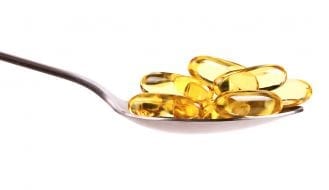


Related posts
